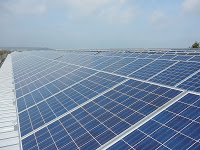 |
| Wiki image |
In the world of solar energy, organic photovoltaic solar cells have a wide range of potential applications, but they are still considered an upstart. While these carbon-based cells, which use organic polymers or small molecules as semiconductors, are much thinner and less expensive to produce than conventional solar cells made with inorganic silicon wafers, they still lag behind in their ability to efficiently convert sunlight into electricity.
Now, UCLA researchers and their colleagues from China and Japan have shown that by incorporating gold nanoparticles into these organic photovoltaics — taking advantage of the plasmonic effect, by which metal helps to enhance the absorption of sunlight — they can significantly improve the cells’ power conversion.
In a paper recently published in ACS Nano, the team of researchers, led by Yang Yang, a professor of materials science and engineering at the UCLA Henry Samueli School of Engineering and Applied Science and director of the Nano Renewable Energy Center at UCLA’s California NanoSystems Institute, demonstrate how they sandwiched a layer of gold nanoparticles between two light-absorbing subcells in a tandem polymer solar cell in order to harvest a greater fraction of the solar spectrum.
They found that by employing the interconnecting gold-nanoparticle layer, they were able to enhance power conversion by as much as 20 percent. The gold nanoparticles create a strong electromagnetic field inside the thin organic photovoltaic layers by a plasmonic effect, which concentrates light so that much more of it can be absorbed by the subcells.
The team is the first to report a plasmonic-enhanced polymer tandem solar cell, having overcome the difficulties involved in incorporating metal nanostructures into the overall device structure.
“We have successfully demonstrated a highly efficient plasmonic polymer tandem solar cell by simply incorporating gold nanoparticles layer between two subcells,” Yang said. “The plasmonic effect happening in the middle of the interconnecting layer can enhance both the top and bottom subcells simultaneously — a ‘sweet spot’ — leading to an improvement in the power conversion efficiency of the tandem solar cell from 5.22 percent to 6.24 percent. The enhancement ratio is as high as 20 percent.”
The research team included Xing Wang Zhang from the Key Lab of Semiconductor Materials Science at the Institute of Semiconductors at Beijing’s Chinese Academy of Science and Ziruo Hong from the Graduate School of Science and Engineering at Japan’s Yamagata University.
Experimental and theoretical results demonstrate that the enhancement effect was attained from local near-field enhancement of the gold nanoparticles. The results show that the plasmonic effect has great potential for the future development of polymer solar cells. The team’s proposed interlayer structures as an open platform can be applied to various polymer materials, opening up opportunities for highly efficient, multi-stacked tandem solar cells.
The research was financially supported by grants from the U.S. Office of Naval Research and the National Science Foundation.
The team also included Jun Yang, Jingbi You, Chun-Chao Chen, and Wan-Ching Hsu of the UCLA Department of Materials Science and Engineering and the California NanoSystems Institute.
Yang was recently named the holder of the Carol and Lawrence E. Tannas Jr. Endowed Chair in Engineering. This chair is the first in the world dedicated to the area of electronic information displays.
See the article in context at the UCLA Newsroom.
linkwithin_text=’Related Articles:’


Be the first to comment on "Nano gold particles used to boost organic solar cell efficiency"